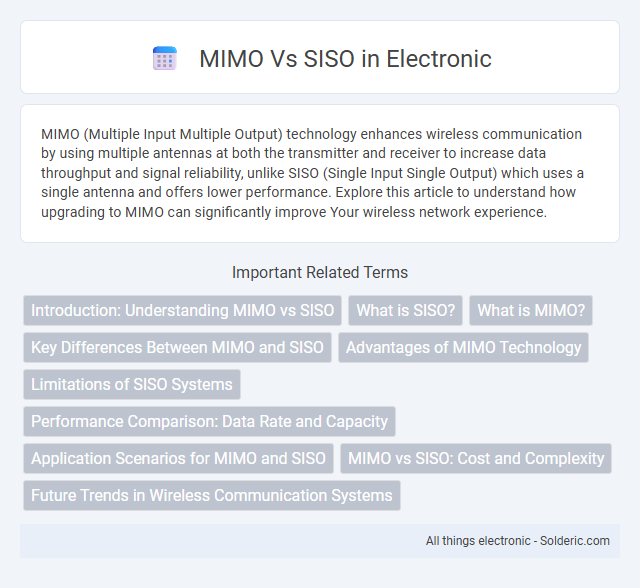MIMO (Multiple Input Multiple Output) technology enhances wireless communication by using multiple antennas at both the transmitter and receiver to increase data throughput and signal reliability, unlike SISO (Single Input Single Output) which uses a single antenna and offers lower performance. Explore this article to understand how upgrading to MIMO can significantly improve Your wireless network experience.
Comparison Table
| Feature | MIMO (Multiple Input Multiple Output) | SISO (Single Input Single Output) |
|---|---|---|
| Definition | Wireless technology using multiple antennas at both transmitter and receiver | Wireless system using a single antenna at transmitter and receiver |
| Data Throughput | Higher throughput via spatial multiplexing | Lower throughput, limited by single antenna capacity |
| Signal Reliability | Improved reliability through spatial diversity | Lower reliability, more prone to fading |
| Range | Extended range with beamforming techniques | Shorter range due to single antenna power |
| Complexity | High; requires advanced signal processing | Low; simpler design and implementation |
| Use Cases | Wi-Fi 5/6, 4G LTE, 5G networks | Basic radio, traditional cellular systems |
Introduction: Understanding MIMO vs SISO
MIMO (Multiple Input Multiple Output) technology significantly enhances wireless communication by using multiple antennas at both the transmitter and receiver ends, increasing data throughput and signal reliability compared to SISO (Single Input Single Output), which uses a single antenna for transmission and reception. MIMO leverages spatial multiplexing and diversity gains to improve wireless network capacity and coverage, making it ideal for high-speed internet and robust mobile connections. Understanding these key differences helps you optimize network performance by choosing the appropriate system based on your bandwidth and signal quality requirements.
What is SISO?
SISO (Single Input Single Output) refers to a wireless communication system using one antenna at both the transmitter and receiver ends, transmitting and receiving a single data stream. It simplifies design but limits data throughput and coverage due to its single transmission path. In contrast to MIMO, which employs multiple antennas to enhance capacity and reliability, SISO offers lower spectral efficiency and less resilience to channel impairments.
What is MIMO?
MIMO (Multiple Input Multiple Output) is a wireless communication technology that uses multiple antennas at both the transmitter and receiver ends to improve data throughput and signal reliability. Unlike SISO (Single Input Single Output), which relies on a single antenna for transmission and reception, MIMO exploits spatial diversity and multiplexing to enhance spectral efficiency and reduce interference. This technology is fundamental in modern wireless standards such as Wi-Fi 6 and 5G, enabling higher capacity and faster wireless connections.
Key Differences Between MIMO and SISO
MIMO (Multiple Input Multiple Output) uses multiple antennas at both the transmitter and receiver to enhance data throughput and signal reliability, while SISO (Single Input Single Output) relies on a single antenna for transmission and reception. MIMO significantly improves spectral efficiency and minimizes multipath fading effects compared to SISO, which can experience greater signal degradation in complex environments. Understanding these key differences helps you optimize wireless network performance based on application requirements and environmental conditions.
Advantages of MIMO Technology
MIMO (Multiple Input Multiple Output) technology significantly enhances wireless communication by utilizing multiple antennas at both the transmitter and receiver ends, improving data throughput and spectral efficiency over SISO (Single Input Single Output) systems. The use of spatial multiplexing in MIMO enables simultaneous transmission of multiple data streams, resulting in higher capacity and reduced latency. Additionally, MIMO offers increased signal reliability through diversity gain, effectively mitigating multipath fading and enhancing overall network performance in dense urban environments.
Limitations of SISO Systems
SISO systems face significant limitations in data throughput and spectral efficiency due to their single antenna configuration, which restricts spatial diversity and multiplexing capabilities. This lack of diversity results in reduced resilience to multipath fading and increased vulnerability to interference, impairing signal quality and reliability. Consequently, SISO systems deliver lower overall performance compared to MIMO technology, which leverages multiple antennas to enhance capacity, reliability, and communication range.
Performance Comparison: Data Rate and Capacity
MIMO (Multiple Input Multiple Output) systems significantly outperform SISO (Single Input Single Output) in data rate and capacity by utilizing multiple antennas to transmit and receive parallel data streams, thereby multiplying throughput. MIMO leverages spatial multiplexing, allowing higher data rates in the same bandwidth, while SISO relies on a single antenna path limiting its maximum data rate and capacity. In wireless communications, MIMO technology enhances spectral efficiency and reliability, leading to superior network performance compared to traditional SISO systems.
Application Scenarios for MIMO and SISO
MIMO (Multiple Input Multiple Output) technology excels in high-density environments such as urban cellular networks, Wi-Fi hotspots, and large-scale enterprise networks where multiple antennas improve data throughput, reliability, and spectral efficiency. SISO (Single Input Single Output) is ideal for simple, low-cost applications like basic home networking, IoT devices, and rural wireless communication where limited bandwidth and lower complexity suffice. MIMO suits scenarios requiring enhanced signal robustness and high data rates, while SISO fits low-power, low-data-rate use cases with minimal hardware requirements.
MIMO vs SISO: Cost and Complexity
MIMO systems require multiple antennas and advanced signal processing algorithms, leading to higher manufacturing and implementation costs compared to SISO systems, which use a single antenna and simpler technology. The increased hardware complexity in MIMO results in greater power consumption and the need for more sophisticated RF components. However, the enhanced data rates and reliability offered by MIMO often justify the additional investment in complex infrastructure.
Future Trends in Wireless Communication Systems
MIMO (Multiple-Input Multiple-Output) technology significantly enhances wireless communication capacity and reliability compared to SISO (Single-Input Single-Output) by utilizing multiple antennas for simultaneous data transmission and reception. Future trends in wireless systems emphasize Massive MIMO and intelligent beamforming to support ultra-high data rates and low latency for 5G and beyond networks. Integration with AI-driven adaptive algorithms will further optimize spectral efficiency, energy consumption, and network scalability in next-generation wireless infrastructures.
MIMO vs SISO Infographic

 solderic.com
solderic.com